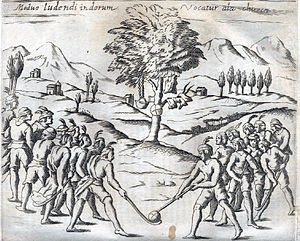Contents

Palin (Mapuche: palin, Spanish: palín) is a traditional game of the Mapuche people of South America. It is broadly similar to field hockey, with two teams using sticks to move a ball across a goal line defended by their opponents. The Spanish conquistadors called it chueca, because it resembled a Spanish game of that name. Palin is the only pre-Columbian Mapuche game that has survived into the present day.[1]
History
Nineteenth-century scholars, such as Chilean historian Diego Barros Arana, believed that the Spanish had introduced the game of chueca to the Mapuche.[2] However, more recent scholarship indicates that palin was already widely played by the Mapuche when the Spanish first conquered the region, and was most likely an ancient indigenous custom that the Spanish named after the similar game from their own homeland.[3]
Prior to the arrival of the Spanish, palin was often played for ritual purposes or as preparation for warfare.[4] Because of these associations, the Spanish colonial government of Chile repeatedly banned palin during the 17th and 18th centuries, but it was revived when Chile gained independence in the early 19th century.[5] In more recent times it has been played primarily as a recreational sport,[3] although some communities still hold palin games as a ritual for special occasions and other social gatherings.[6]
Description
Palin is played by two opposing teams on a long, narrow, rectangular field on flat ground.[7] Exact dimensions vary, but a typical field would be 200 meters long and 12 meters wide.[8] The number of players on the teams can vary, as long both teams are of equal size.[7][8]
Play begins with a wood or leather ball placed in the center of the field. Players use curved wooden sticks to move the ball down the long axis of the field and across the goal line on the opposing team's side. Score is kept as the difference in goals between the two teams. Each goal is worth one point, and when the trailing team makes a goal, a point is deducted from score of the team in the lead. A team must score four consecutive unanswered points to win a game.[8][9]
Players often make strong physical contact as they maneuver for control of the ball; injuries during a game are common.[10][11]
References
- ^ Von Vriessen 2002, p. 627.
- ^ Barros Arana 1999, p. 77 n38.
- ^ a b Von Vriessen 2002, p. 633.
- ^ Course 2011, pp. 122–126.
- ^ Von Vriessen 2002, p. 628.
- ^ "Palin hoy: sentidos y significados de una práctica viva" [Palin today: senses and meanings of a living practice]. Palin: un encuentro espiritual, social y político (in Spanish). Museo Mapuche de Cañete. Retrieved 17 February 2022.
- ^ a b Course 2011, p. 119.
- ^ a b c Von Vriessen 2001, p. 71.
- ^ Course 2011, p. 121.
- ^ Course 2011, p. 125.
- ^ Reuque Paillalef 2002, p. 111.
Works cited
- Barros Arana, Diego (1999) [1884]. Historia General de Chile (in Spanish). Vol. I. Santiago, Chile: Editorial Universitaria. ISBN 978-956-11-1533-0.
- Course, Magnus (2011). Becoming Mapuche: Person and Ritual in Indigenous Chile. Interpretations of Culture in the New Millennium series. Urbana, Illinois: University of Illinois Press. ISBN 978-0-252-03647-7.
- Reuque Paillalef, Rosa Isolde (2002). Mallon, Florencia E. (ed.). When a Flower Is Reborn: The Life and Times of a Mapuche Feminist. Durham, North Carolina: Duke University Press. ISBN 978-0-8223-8421-2.
- Von Vriessen, Carlos Lopez (2001). "Palin (Tribal Ball Games)". In Corbett, Doris; Cheffers, John; Sullivan, Eileen Crowley (eds.). Unique Games and Sports Around the World: A Reference Guide. Westport, Connecticut: Greenwood Publishing Group. ISBN 978-0-313-29778-6.
- Von Vriessen, Carlos Lopez (2002). "Chile: Sport for All as 'Social Physical Education'". In da Costa, Lamartine P.; Miragaya, Ana (eds.). Worldwide Experiences and Trends in Sport for All. Meyer & Meyer Sport. ISBN 978-1-84126-085-3.
Further reading
- Von Vriessen, Carlos Lopez (2011). El Palin: Juego Tradicional de la Cultura Mapuche (in Spanish). Valparaíso, Chile: Ediciones Universitarias de Valparaíso. ISBN 978-956-17-0493-0.
External links
- "Palin: un encuentro espiritual, social y político" [Palin: a spiritual, social and political encounter] (in Spanish). Mapuche Museum of Cañete. Retrieved 17 February 2022.

